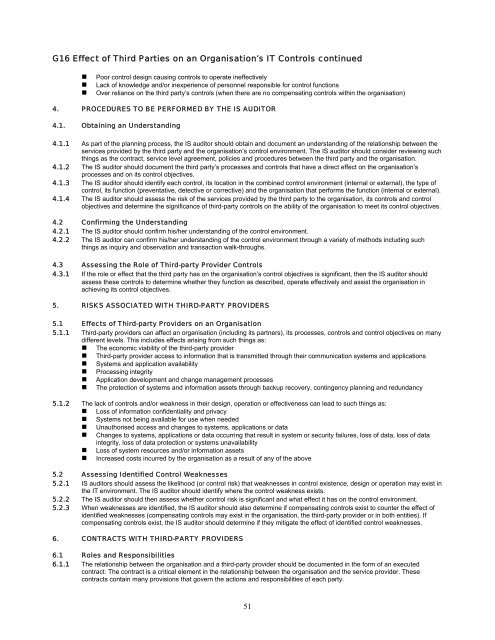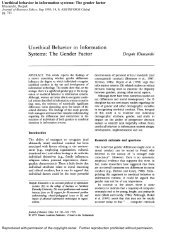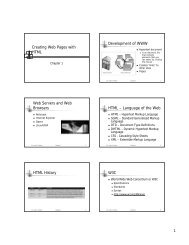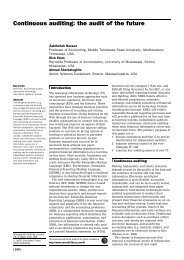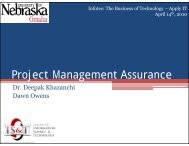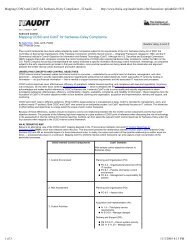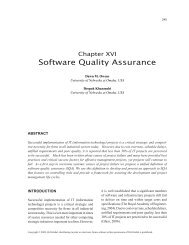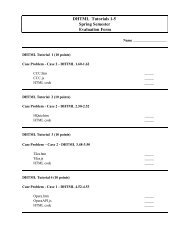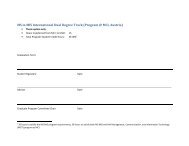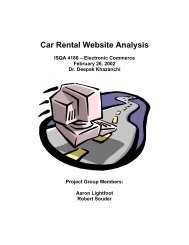IS Standards, Guidelines and Procedures for Auditing and Control ...
IS Standards, Guidelines and Procedures for Auditing and Control ...
IS Standards, Guidelines and Procedures for Auditing and Control ...
Create successful ePaper yourself
Turn your PDF publications into a flip-book with our unique Google optimized e-Paper software.
G16 Effect of Third Parties on an Organisation’s IT <strong>Control</strong>s continued• Poor control design causing controls to operate ineffectively• Lack of knowledge <strong>and</strong>/or inexperience of personnel responsible <strong>for</strong> control functions• Over reliance on the third party’s controls (when there are no compensating controls within the organisation)4. PROCEDURES TO BE PERFORMED BY THE <strong>IS</strong> AUDITOR4.1. Obtaining an Underst<strong>and</strong>ing4.1.1 As part of the planning process, the <strong>IS</strong> auditor should obtain <strong>and</strong> document an underst<strong>and</strong>ing of the relationship between theservices provided by the third party <strong>and</strong> the organisation’s control environment. The <strong>IS</strong> auditor should consider reviewing suchthings as the contract, service level agreement, policies <strong>and</strong> procedures between the third party <strong>and</strong> the organisation.4.1.2 The <strong>IS</strong> auditor should document the third party’s processes <strong>and</strong> controls that have a direct effect on the organisation’sprocesses <strong>and</strong> on its control objectives.4.1.3 The <strong>IS</strong> auditor should identify each control, its location in the combined control environment (internal or external), the type ofcontrol, its function (preventative, detective or corrective) <strong>and</strong> the organisation that per<strong>for</strong>ms the function (internal or external).4.1.4 The <strong>IS</strong> auditor should assess the risk of the services provided by the third party to the organisation, its controls <strong>and</strong> controlobjectives <strong>and</strong> determine the significance of third-party controls on the ability of the organisation to meet its control objectives.4.2 Confirming the Underst<strong>and</strong>ing4.2.1 The <strong>IS</strong> auditor should confirm his/her underst<strong>and</strong>ing of the control environment.4.2.2 The <strong>IS</strong> auditor can confirm his/her underst<strong>and</strong>ing of the control environment through a variety of methods including suchthings as inquiry <strong>and</strong> observation <strong>and</strong> transaction walk-throughs.4.3 Assessing the Role of Third-party Provider <strong>Control</strong>s4.3.1 If the role or effect that the third party has on the organisation’s control objectives is significant, then the <strong>IS</strong> auditor shouldassess these controls to determine whether they function as described, operate effectively <strong>and</strong> assist the organisation inachieving its control objectives.5. R<strong>IS</strong>KS ASSOCIATED WITH THIRD-PARTY PROVIDERS5.1 Effects of Third-party Providers on an Organisation5.1.1 Third-party providers can affect an organisation (including its partners), its processes, controls <strong>and</strong> control objectives on manydifferent levels. This includes effects arising from such things as:• The economic viability of the third-party provider• Third-party provider access to in<strong>for</strong>mation that is transmitted through their communication systems <strong>and</strong> applications• Systems <strong>and</strong> application availability• Processing integrity• Application development <strong>and</strong> change management processes• The protection of systems <strong>and</strong> in<strong>for</strong>mation assets through backup recovery, contingency planning <strong>and</strong> redundancy5.1.2 The lack of controls <strong>and</strong>/or weakness in their design, operation or effectiveness can lead to such things as:• Loss of in<strong>for</strong>mation confidentiality <strong>and</strong> privacy• Systems not being available <strong>for</strong> use when needed• Unauthorised access <strong>and</strong> changes to systems, applications or data• Changes to systems, applications or data occurring that result in system or security failures, loss of data, loss of dataintegrity, loss of data protection or systems unavailability• Loss of system resources <strong>and</strong>/or in<strong>for</strong>mation assets• Increased costs incurred by the organisation as a result of any of the above5.2 Assessing Identified <strong>Control</strong> Weaknesses5.2.1 <strong>IS</strong> auditors should assess the likelihood (or control risk) that weaknesses in control existence, design or operation may exist inthe IT environment. The <strong>IS</strong> auditor should identify where the control weakness exists.5.2.2 The <strong>IS</strong> auditor should then assess whether control risk is significant <strong>and</strong> what effect it has on the control environment.5.2.3 When weaknesses are identified, the <strong>IS</strong> auditor should also determine if compensating controls exist to counter the effect ofidentified weaknesses (compensating controls may exist in the organisation, the third-party provider or in both entities). Ifcompensating controls exist, the <strong>IS</strong> auditor should determine if they mitigate the effect of identified control weaknesses.6. CONTRACTS WITH THIRD-PARTY PROVIDERS6.1 Roles <strong>and</strong> Responsibilities6.1.1 The relationship between the organisation <strong>and</strong> a third-party provider should be documented in the <strong>for</strong>m of an executedcontract. The contract is a critical element in the relationship between the organisation <strong>and</strong> the service provider. Thesecontracts contain many provisions that govern the actions <strong>and</strong> responsibilities of each party.51


